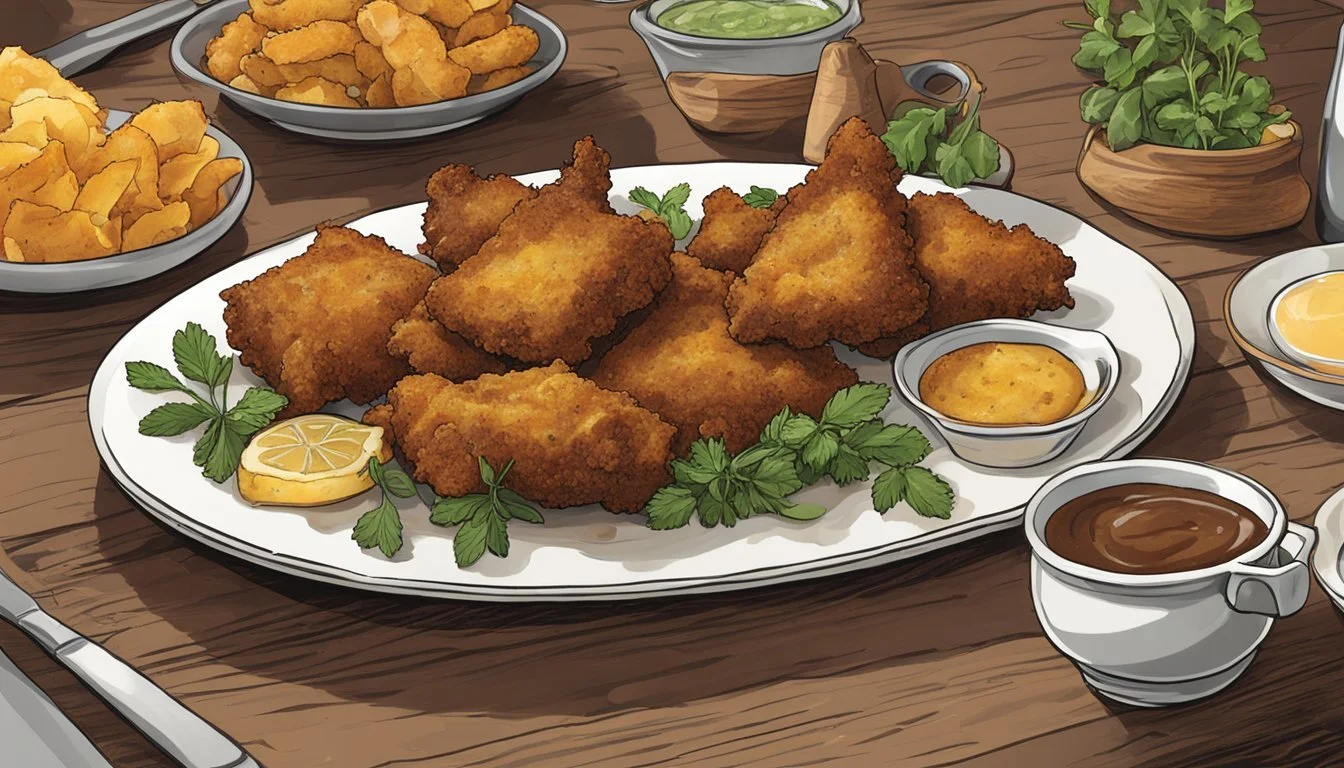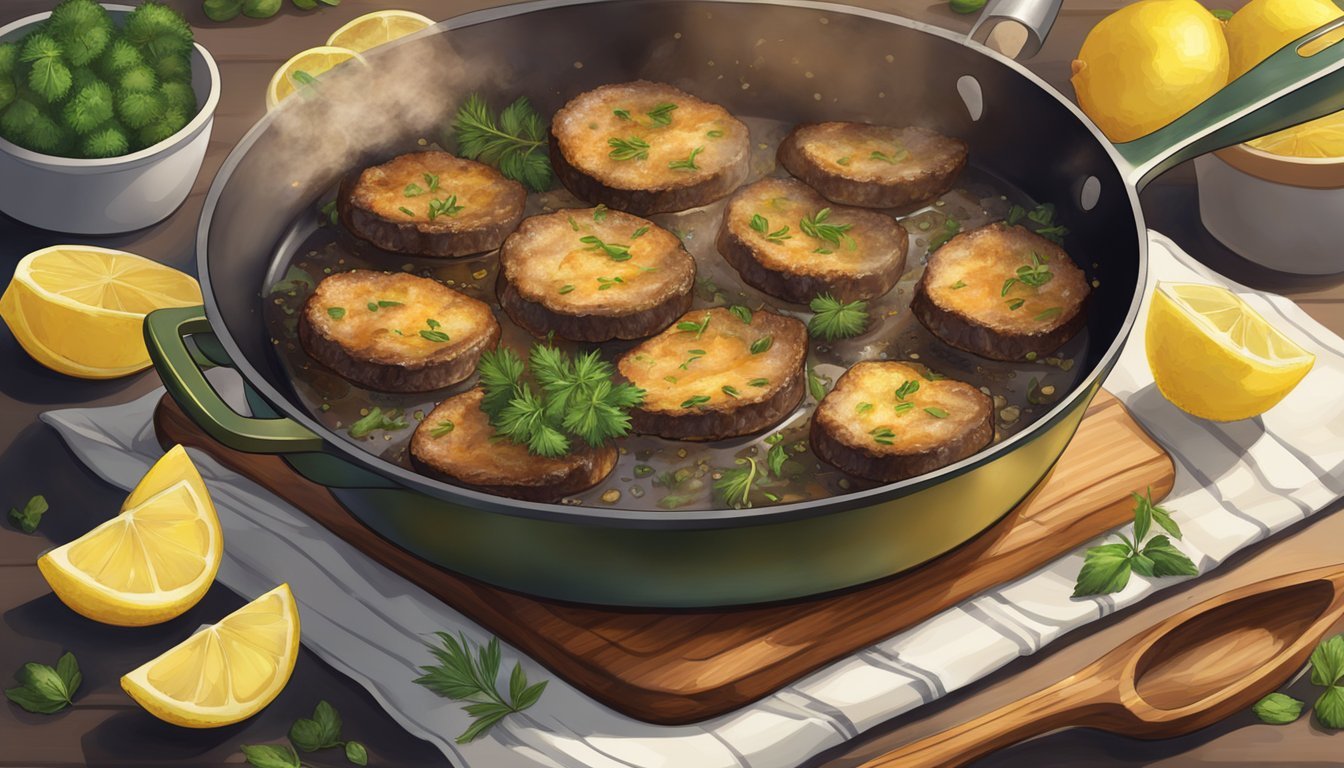Fried Cow Udder
Discovering Italy's Unique Delicacy 'Fried Teteun'
Italian cuisine is renowned for its diversity and innovation, stretching beyond the familiar plates of pasta and pizza to include an array of lesser-known regional specialties. One such specialty is the fried cow udder, or 'Fried Teteun,' a dish that may raise eyebrows yet is steeped in Italian culinary tradition. Originating from the Valle d'Aosta region, a smaller yet gastronomically rich area nestled in the Alps, this dish showcases the Italian penchant for utilizing a vast range of ingredients, including those that are often overlooked elsewhere.
The preparation of Fried Teteun is meticulous, capturing the essence of Italian dedication to culinary craft. Cow udders are initially cured and, in some regions, seasoned carefully to develop rich flavors. Cooked in salted water until tender and then sliced, the udder pieces are seasoned, breaded, and fried to a golden crispness. This method transforms the udder's texture into a palatable delicacy, offering a unique experience to both locals and gastronomic adventurers alike.
Italy's cultural heritage and traditions are embedded in its regional dishes, with each area of the country, from Tuscany to Sicily and Milan to Rome, contributing its own distinct flavors to the national palate. Fried Teteun, with its singular taste and texture, embodies the spirit of Italian food: (What wine goes well with Italian food?) bold, inventive, and unafraid to embrace every facet of gastronomic possibility. Through such unusual specialties, Italy continually reaffirms its status as a powerhouse of culinary diversity, inviting eaters to explore the rich tapestry that shapes its enduring food culture.
Historical Significance of Fried Teteun
Fried Teteun is steeped in the culinary traditions of Italy's Valle d'Aosta region. This distinctive dish represents a connection to the area's agricultural past, where nothing went to waste. Teteun, essentially the Italian term for cow udder, is a food deeply ingrained in the local culture. It exemplifies the resourcefulness of Italian peasant cooking, transforming a less sought-after part of the cow into a sought-after delicacy.
Origin: Traditionally, the preparation of Teteun was a means to use every part of the cow, aligning with the Italian ethos of 'cucina povera' or 'poor kitchen'.
Preparation: The udders, after being carefully cleaned, are salted and sometimes seasoned with herbs. They're then left to cure, following a method that ensures the preservation and enhancement of their natural flavors.
Culinary Role: The resulting product is often fried and served, providing a rich and unique flavor profile that has been enjoyed for generations.
The dish's significance goes beyond its ingredients; it's a testament to the region's history and its peoples' relationship with their environment. Cow udders, while not a common ingredient in many parts of the world, are celebrated in Valle d'Aosta for their texture and taste. The community's pride in this dish is evident during food festivals dedicated to the Teteun, where it takes center stage, showcasing the region's cultural heritage and culinary innovation.
Fried Teteun has not only been preserved but is relished as a part of Valle d'Aosta's living traditions. It provides a direct link to the past, maintaining a place in the hearts and on the tables of those in the region, and offering a unique taste of Italy's rich and diverse gastronomic landscape.
Fried Teteun Preparation Basics
Mastering the preparation of Fried Teteun begins with understanding the right ingredients and techniques. Careful handling of the udder, making a suitable batter, and employing the correct frying method are essential.
Ingredients
Fresh cow udder
Eggs
Fine breadcrumbs
Salt
Pepper
Olive oil or butter, for frying
Lemon juice (optional, for serving)
Preparing the Udder
The key to preparing Fried Teteun starts with thoroughly cleaning the udder to remove any traces of milk. It should be soaked in lukewarm water initially for 2 to 4 hours, allowing the water to gradually cool. After soaking, the udder is to be cooked in a 2% to 3% salt water solution until tender.
Batter and Breading
Once the udder is tender, it is removed from the cooking liquid and sliced into ½-inch thick pieces. Each slice should be allowed to dry. Then, they are seasoned with salt and pepper—both sides—before being dipped in whisked egg, ensuring complete coating. Immediately following the egg, each slice is dredged in fine breadcrumbs, ready for frying.
Frying Technique
To achieve the golden-brown perfection characteristic of Fried Teteun, a frying pan is filled with enough olive oil or butter to coat its surface. The breaded udder slices are fried, turning once to ensure an even cook. They should be golden brown on both sides. Fried Teteun is often served with a squeeze of lemon juice to enhance its flavor.
Serving and Presentation
When serving Fried Teteun, the presentation should capture the essence of Italian culinary tradition, aiming for simplicity yet elegance. Proper accompaniments and garnishing can elevate the dish, enhancing both its flavors and visual appeal.
Accompaniments
Fried Teteun pairs excellently with a variety of Italian sides. A simple pasta dressed with a light tomato sauce complements the dish without overshadowing the unique taste of the udder. A fresh salad with tomatoes, basil, and other herbs offers a crisp, refreshing counterpoint. For a more hearty option, roasted vegetables (What wine goes well with roasted vegetables?) seasoned with parsley lend earthy notes that can stand up to the rich, fried udder.
Pasta: al dente, light tomato sauce
Salad: fresh greens, basil, vin aigrette
Roasted Vegetables: seasoned with parsley
Garnishing Tips
Garnishes should not only add color and contrast but also complement the flavor profile of the Fried Teteun. A wedge of lemon provides acidity to cut through the richness, while a sprinkle of Parmesan cheese adds a savory touch that meshes well with the dish's Italian roots. Fresh herbs like parsley or basil can be used as a final touch to give a burst of freshness and color.
Lemon: squeezed for freshness
Parmesan Cheese: freshly grated for a savory note
Herbs: parsley or basil, finely chopped
Fried Teteun in Italian Cuisine
Fried Teteun is a distinctive dish in Italian cuisine, originating from the Aosta Valley, which highlights the inventive utilization of cow udder, a byproduct often overlooked in other culinary traditions.
Regional Variations
In Italian cuisine, the preparation and consumption of offal, known locally as quinto quarto, has given rise to a variety of regional specialties, each with its own unique method of preparation. Fried Teteun, or corned cow udder, is a savory dish that is specifically tied to the Aosta Valley region. It demonstrates the area's resourceful culinary approach to using all parts of the cow. Historically, this approach was rooted in maximizing the nutrition gleaned from livestock, particularly by poorer populations.
Different regions in Italy have developed their own versions of offal dishes, such as Roman tripe (Trippa alla Romana) and coda alla vaccinara (oxtail stew), Tuscan lampredotto, Roman pajata (intestines of an unweaned calf), and Florentine cibreo (a mix of chicken liver, unlaid eggs, and other animal parts). These dishes, like Fried Teteun, reflect the tradition of nose-to-tail eating, a philosophy that respects the animal by minimizing waste.
Italian Street Food
Offal has long been a staple in Italian street food, frequented by locals and adventurous visitors alike. In the pantheon of Italian street food, lampredotto stands out as particularly popular; it is often served in a sandwich and can be found in various food stalls and markets throughout Tuscany. Similarly, Fried Teteun could easily find its spot among Italian street food favorites, both for its rich flavor and its reflection of Italian culinary ingenuity.
Restaurants specializing in local cuisine might offer Fried Teteun as an intriguing option for diners seeking authentic regional dishes. The dish requires skillful preparation, typically involving the careful pressing of the udder to remove milk residue before corning. It is then sliced, seasoned, coated in egg and breadcrumbs, and fried to a golden brown. This meticulous process highlights the dish's artisanal character and connects it with other carefully prepared Italian dishes that often grace the menus of establishments aiming to provide an authentic taste of local flavor.
Pairing with Other Foods
Fried Cow Udder, or 'Fried Teteun', is a distinctive Italian delicacy that pairs well with various dishes and wines. Crafting the perfect meal involves selecting complementary foods and wine pairings that enhance the flavor profile of this unique specialty.
Complementary Dishes
In Italian cuisine, Fried Teteun melds harmoniously with a range of side dishes. It is traditionally accompanied by:
Simple pasta dishes such as spaghetti aglio e olio, where the mild garlic and olive oil seasoning doesn't overshadow the rich taste of the udder.
A side of beans, particularly cannellini or borlotti, offers a creamy texture that pairs delightfully with the meat's crispy exterior.
Fresh salads, incorporating crispy lettuce and thinly sliced zucchini, provide a light contrast to the dish's rich savor.
Vegetables like greens such as chard or spinach are commonly served stewed, their earthiness complimenting the savory fried udder.
For cheese lovers, mild mozzarella cheese is a choice addition, either melted over the top or served as part of a caprese salad (What wine goes well with caprese salad?).
Wine Pairings
Selecting the proper wine enhances the culinary experience of enjoying Fried Teteun. Consider these pairings:
Red wines such as Chianti or Barbera offer acidity and tannins that cut through the richness of the fried udder.
For a white option, a full-bodied Verdicchio or Trebbiano balances the dish's robust flavors.
The selection of the right dish and wine pairing brings forth the subtleties of Fried Cow Udder and allows for a truly Italian gastronomic delight.
Health and Nutrition
Fried cow udder, known in parts of Italy as 'Fried Teteun', is a dish that might raise eyebrows due to its unconventional main ingredient. In considering the health and nutritional aspects, it is important to analyze the key components of the dish.
Nutritional Components:
Cow Udder: Rich in protein and contains various minerals, but the fat content is relatively high.
Egg: Provides additional protein and serves as a source of vitamins, particularly B-vitamins as well as fat-soluble vitamins A, D, E, and K.
Breadcrumbs: Adds carbohydrates to the dish, and depending on the type, can contribute fiber if whole grain.
Butter/Olive Oil: Used for frying, and although both add fats, olive oil provides heart-healthy monounsaturated fats, whereas butter is high in saturated fats.
Preparation Impact: The method of cooking, which involves frying in butter or olive oil, can increase the calorie content significantly. The choice between these two fats can also affect the nutritional profile: olive oil is often considered a healthier option due to its lower saturated fat content.
Table: Nutritional Overview
Ingredient Nutrient Contribution Cow Udder Protein, Fat, Minerals Egg Protein, Vitamins, Fat Breadcrumbs Carbohydrates, Fiber Butter Saturated Fat Olive Oil Monounsaturated Fat
In moderation, 'Fried Teteun' can be part of a varied diet. Consumers may benefit from the protein and vitamins provided by the eggs and potential mineral intake from the cow udder. However, mindful consumption is key, especially considering the potential for high fat and calorie content due to the cooking process.
Handling and Storage Tips
When dealing with fried cow udder, commonly known in Italy as 'Fried Teteun', proper handling and storage are crucial to ensure it remains a safe and delicious delicacy. Before cooking, one must thoroughly clean the udder. They should place it in lukewarm water to remove all traces of milk, soaking it for 2 to 4 hours which allows the water to cool off gradually. This step is vital to avoid any milk residue that may spoil the taste or texture of the dish.
After cleaning, the udder requires cooking in a saline solution to achieve tenderness. Using a 2-3% salt water solution is recommended for this purpose. Once cooked to tender perfection, they should promptly remove the udder from the liquid to prevent it from becoming overly soft or mushy.
Before proceeding to the frying stage, it is important to slice the udder into equally thick pieces to ensure even cooking. After slicing, allowing the pieces to dry somewhat makes it easier to achieve a crispy golden crust when fried.
For storage, the raw udder should be kept refrigerated at a temperature below 40°F (4°C) to prevent bacterial growth. It is best to store it in a sealed container to avoid cross-contamination with other foods. If one has cooked the udder but plans to consume it later, they must refrigerate it within two hours of cooking. In the refrigerator, the fried cow udder can be stored for 3-4 days in an airtight container.
To summarize, proper handling and storage of the cow udder involves:
Cleaning: Soak in lukewarm water to remove milk.
Cooking: Boil in a 2-3% salt water solution until tender.
Slicing: Cut into 1/2-inch thick slices post-boiling.
Drying: Allow slices to air dry slightly for crispiness upon frying.
Refrigeration: Store both raw and cooked udder below 40°F.
Adhering to these tips will help ensure that the quality and flavor of the fried cow udder are preserved, making it a safe and enjoyable dish to savor.
Where to Find Fried Teteun
Fried Teteun, a distinctive Italian culinary preparation, is primarily located in the Valle d'Aosta region. This unique dish, made from cow udder, is not commonly found outside of this area, reflecting its deeply ingrained cultural heritage. Visitors seeking to experience this Italian specialty can explore the traditional restaurants within Valle d'Aosta itself.
In major Italian cities such as Milan and Rome, finding this particular fare might require a more dedicated search. Authentic Italian cuisine enthusiasts may discover select restaurants that celebrate regional dishes, which could include Fried Teteun. However, it's less prevalent compared to more widely recognized Italian foods.
Moving towards regions like Sicily or Tuscany, Fried Teteun is less likely to appear on local menus, as these regions boast their own culinary identities separate from that of Valle d'Aosta.
For those committed to tasting this rare dish, the following are recommended steps:
Research: Look for restaurants that specialize in Valle d'Aosta cuisine or offer a wider variety of regional specialties.
Travel: Plan a visit to Valle d'Aosta for the most traditional experience.
Inquire locally: Ask locals in Italian cities for recommendations as they might know hidden gems that serve Fried Teteun.
Below is a succinct overview of where Fried Teteun might be found:
Valle d'Aosta: Widely available in traditional eateries
Milan: Select restaurants with regional specialties
Rome: Potentially in niche dining establishments
Sicily: Unlikely due to distinct regional cuisine
Tuscany: Rare, given its own rich culinary heritage
In summary, while Fried Teteun can be elusive, food enthusiasts may be rewarded by focusing their search within Valle d'Aosta, or by seeking out specialty Italian restaurants in the larger cities of Italy.
Making Fried Teteun at Home
Fried Teteun, a distinctive dish from the Italian cuisine, offers a unique taste experience. This delicacy employs cow's udder as its central ingredient, a choice reflecting the resourcefulness of traditional cooking. To begin, the udder should be cooked in a mildly salted water solution to ensure tenderness.
Preparation Steps:
Cook the udder in a 2-3% salt water solution.
Once tender, remove and slice into 1/2-inch thick pieces. Let them dry slightly.
Season each slice with black pepper and salt to taste.
For the breading process, two separate bowls are necessary — one containing a whisked egg and another filled with breadcrumbs. The udder slices should be dipped first into the egg and then coated evenly with breadcrumbs.
Cooking Method:
Heat a generous amount of butter or olive oil in a skillet over medium heat.
Fry the breaded udder slices until they achieve a golden brown coloration, ensuring each side is cooked evenly.
Optional garnishes include finely chopped parsley, basil, minced garlic, or slivers of onion. These add a fresh, aromatic touch to the fried Teteun, harmonizing with the rich flavors.
By following these straightforward steps, one can master the preparation of Fried Teteun at home, bringing a taste of Italian tradition to the dinner table.
Potential Variations and Substitutions
In preparing Fried Cow Udder, chefs and home cooks alike may encounter the need to adapt the recipe due to dietary preferences or ingredient availability. This section explores possible substitutions that maintain the dish's essence while providing flexibility.
Alternative Ingredients
Eggs: They act as a binding agent for the breadcrumbs. A potential substitution could be a flaxseed meal or chickpea water mixture, known as aquafaba, which can mimic egg's binding properties.
Milk: Used in various stages of preparation, particularly if incorporating it into a meatball version of the dish. Substitutes like almond or soy milk can be used for those avoiding dairy.
Butter: Key for frying and flavor. For a healthier version or for lactose intolerance, consider olive oil with its high smoke point and distinct flavor.
Parmesan Cheese: A classic staple in Italian cooking, adding umami. Nutritional yeast or vegan parmesan alternatives can be used in place of traditional cheese to cater to vegan diets.
Vegetarian Options
Fried Cow Udder is inherently a meat-based dish, making vegetarian options more of an adaptation than a straight substitution.
Zucchini: Sliced and treated similarly to the cow udder preparation, it can offer a vegetarian-friendly texture with a satisfying bite. Incorporating lemon juice into the seasoning can add brightness to the dish.
Mock Meats: An approach for those wanting to retain a meat-like experience could include commercially available mock meat products designed to mimic the texture and flavor of animal-based ones.
Fried Teteun's Place in Modern Gastronomy
In contemporary Italian cuisine, Fried Teteun maintains its role as a testament to regional cultural heritage, especially in Valle d'Aosta where it originates. Traditionally, Teteun is veal udder, which, after a curing process, is served fried, making it one of the more singular Italian delicacies. Its preservation in the modern culinary scene reflects Italian food's strong ties to tradition.
Restaurants in Italy, particularly in Valle d'Aosta, uphold the preparation and serving of Fried Teteun as a cultural staple. While not as commonly found as mainstream Italian dishes like pasta and pizza, Teteun holds a niche in various boutique eateries and local taverns, where it's celebrated for its uniqueness and connection to local history.
In the context of international Italian food culture, Teteun is less known but can be seen as emblematic of the diverse and extensive landscape of Italian gastronomy. Food enthusiasts often discover it through culinary travel or specialized dining experiences that highlight regional specialties. Ambitious chefs outside Italy who specialize in Italian food sometimes feature Teteun, adding to their repertoire of authentic regional dishes.
The dish’s sustainability in modern gastronomy is supported by food connoisseurs who appreciate the discovery of rare culinary delights, contributing to diverse food narratives across Europe. Fried Teteun exemplifies how a singular component of a region's history can maintain relevance amidst a rapidly evolving food scene. It epitomizes how Italian cuisine values locality, tradition, and culinary innovation.
Frequently Asked Questions
This section provides essential information regarding the nutritional aspects, cooking advice, and sourcing components for preparing the Italian delicacy 'Fried Teteun', also known as fried cow udder.
Nutritional Concerns
Fried cow udder is a food item rich in protein due to its origin from milk-producing tissues. Milk as a source provides a balanced set of nutrients, and by extension udder inherits some of these benefits. It also contains fats which can be affected by the cooking method. When preparing this dish, one should be aware of the calorie content that frying in butter or olive oil may add.
Cooking Tips
For the best results when cooking fried cow udder, chefs should initially simmer the udder in a 2 to 3-percent salt water solution until it becomes tender. Following this, they cut it into half-inch thick slices, let them dry, and then proceed with seasoning. The slices should be dipped in whisked egg and coated with breadcrumbs before frying. It is important to fry them in a quality fat like butter or olive oil until they achieve a golden-brown color on both sides.
Finding Ingredients
Fried cow udder is a specialty ingredient that may not be readily available in regular markets. It can usually be procured from specialty butchers or stores that cater to Italian cuisine. Sometimes, it may need to be special ordered. For seasonings such as salt and breadcrumbs, these can be sourced from any well-stocked grocery store. High-quality olive oil will also enhance the flavor and texture of the dish.
Conclusion
In the landscape of Italian cuisine, Fried Cow Udder, also known as Fried Teteun, reflects the diversity and regional uniqueness that characterizes Italy's food traditions. This specialty, rooted in Italian culinary heritage, demonstrates Italy's remarkable ability to create delectable dishes from unconventional ingredients.
Traditionally, the preparation involves simmering the udder in a saltwater solution until tender. It is then sliced, breaded, and fried to a golden hue. Despite its unconventional nature, Fried Cow Udder is just one example of how Italy's culinary practices honor every part of the animal, embodying a zero-waste ethos that has been part of the country's food culture for centuries.
The appreciation of such dishes extends beyond taste; it embraces the cultural heritage and the storied past of Italian gastronomy. Italian food is not monolithic but rather a tapestry woven with diverse threads of regional practices and flavors, with dishes like Fried Cow Udder serving as a testament to the nation’s gastronomic creativity and resilience.
As global palates expand and curiosity about different cuisines grows, Italy’s unusual specialties continue to intrigue and invite conversation, sharing the story of a nation where food is more than sustenance — it is a way of life.













